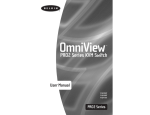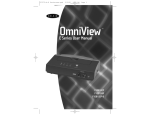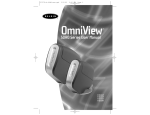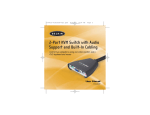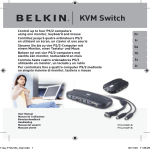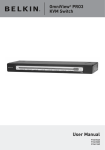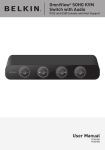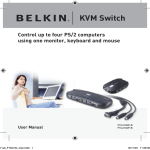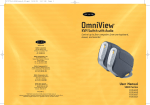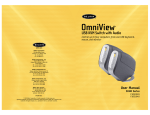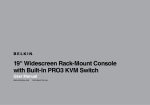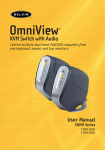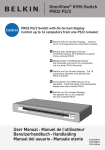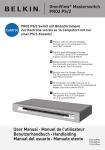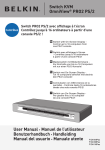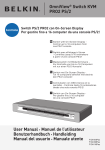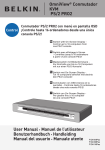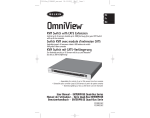Download Belkin Omniview SE Plus Series 2p
Transcript
OmniView KVM Switch ™ Control up to four computers from one PS/2 console belkin.com Belkin Corporation 501 West Walnut Street Compton • CA • 90220 • USA Tel: 310.898.1100 Fax: 310.898.1111 Belkin Components, Ltd. Express Business Park • Shipton Way • Rushden NN10 6GL • United Kingdom Tel: +44 (0) 1933 35 2000 Fax: +44 (0) 1933 31 2000 Belkin Components B.V. Starparc Building • Boeing Avenue 333 1119 PH Schiphol-Rijk • The Netherlands Tel: +31 (0) 20 654 7300 Fax: +31 (0) 20 654 7349 Belkin Components, Ltd. 7 Bowen Crescent • West Gosford NSW 2250 • Australia Tel: +61 (0) 2 4372 8600 Fax: +61 (0) 2 4372 8603 Belkin Tech Support US: 310.898.1100 ext. 2263 800.223.5546 ext. 2263 Europe: 00 800 223 55 460 Australia: 1800 666 040 P74178 © 2002 Belkin Corporation. All rights reserved. All trade names are registered trademarks of respective manufacturers listed. Mac and Mac OS are trademarks of Apple Computer, Inc., registered in the U.S. and other countries. User Manual SE Plus Series F1DZ102T F1DZ104T TABLE OF CONTENTS Introduction . . . . . . . . . . Overview Feature Overview . . . . . Equipment Requirements Operating Systems . . . . Unit Display Diagrams . . Specifications . . . . . . . INTRODUCTION . . . . . . . . . . . . . . . . . . . . . . . . . . . . .1 . . . . . . . . . . . . . . . . . . . . . . . . . . . . . . . . . . . . . . . . . . . . . . . . . . . . . . . . . . . . . . . . . . . . . . . . . . . . . . . . . . . . . . . . . . . . . . . . . . . . . . . . . . . . . . . . . . . . . . . . . . . . . . . . . . . . . . . . . . . . .2 .4 .5 .6 .8 Installation Pre-Configuration . . . . . . . . . . . . . . . . . . . . . . . . . . . . . . . . . .9 Step-by-Step Installation Guide . . . . . . . . . . . . . . . . . . . . . . . .10 Single KVM Switch Installation . . . . . . . . . . . . . . . . . . . . . . . .11 Connecting Multiple KVM Switches (Daisy-Chaining) . . . . . . . . . .14 Powering Up the Systems . . . . . . . . . . . . . . . . . . . . . . . . . . . .17 Using Your Switch Selecting a Computer Using Direct-Access Port Selectors . . . . . . . .18 Selecting a Computer Using Keyboard Hot Key Commands . . . . . . .18 AutoScan Mode . . . . . . . . . . . . . . . . . . . . . . . . . . . . . . . . . .20 FAQs . . . . . . . . . . . . . . . . . . . . . . . . . . . . . . . . . . . . . . . . . . .22 Troubleshooting . . . . . . . . . . . . . . . . . . . . . . . . . . . . . . . . . . . .25 Congratulations on your purchase of this Belkin OmniView SE Plus Series KVM Switch (the Switch). Our diverse line of KVM solutions exemplifies the Belkin commitment to delivering high-quality, durable products at a reasonable price. Designed to give you control over multiple computers and servers from one console, the Switch comes in a variety of capacities suitable for all configurations, large or small. Belkin has designed and developed this KVM Switch with the server administrator in mind. The result is the OmniView SE Plus Series KVM Switch, which surpasses any other switch on the market. The Switch is engineered to work with the most secure IA computing environments, offering enhanced security, intuitive port indicators, direct-access portselection buttons, higher video resolution support, and flash-upgradeable firmware. The Switch also comes with an unparalleled Belkin Five-Year Warranty. This manual will provide details about your new Switch, from installation and operation to troubleshooting in the unlikely event of a problem. For quick and easy installation, please refer to the Quick Installation Guide included in the packaging. Thank you for purchasing the Belkin OmniView SE Plus Series KVM Switch. We appreciate your business and have confidence that you will soon see for yourself why over 1 million Belkin OmniView products are in use worldwide. Warranty, FCC, CE, ICES Statement . . . . . . . . . . . . . . . . . . . . . . . .28 Package Contents • • • • • • OmniView SE Plus Series KVM Switch DB25-to-RJ45 Parallel Flash Cable User Manual Quick Installation Guide 12V DC, 1A AC Power Supply Registration Card 1 OVERVIEW OVERVIEW Feature Overview Direct-Access Port Selectors Direct-access port selectors, located conveniently on the front face of the Switch, allow for simple, manual port-selection. Each button controls a port. The BANK scroll buttons located on the front panel of the Switch let you select daisy-chained switches. Each scroll button corresponds to a daisy-chained switch. You can add more ports to your KVM configuration by connecting SE Plus Series KVM Switches, up to a maximum total of four switches to support as many as 16 computers. Enhanced Security LED Display Directly routes input and output signals to each individual computer, preventing unintended information exchange. An LED display on the face of the Switch serves as a status monitor. An LED next to each direct-access port selector lights to indicate that the console currently controls the corresponding computer. As a port selector is pushed, the LED next to it will light up. A flashing port LED indicates that there is no computer connected to that port. OmniView SE Plus Series KVM Switches allow you to control up to a maximum of 16 computers with one keyboard, monitor, and mouse. They support PS/2 input devices (keyboard and mouse) as well as VGA, SVGA, XGA, and XGA-2 video. It supports both PS/2 and USB output. This enables cross-platform control over PCs and USB-based computers including USB Sun™ workstations and Mac® computers. Hot Keys Hot key functionality allows you to select a desired port using designated key commands. By using a simple hot key sequence on your keyboard, selecting one computer from as many as 16 computers is instantaneous. For a listing of complete hot key instructions and commands, see page 18. AutoScan 7-Segment LED Display When daisy-chaining multiple KVM Switches together, the 7-segment LED display serves as a quick indicator of the selected BANK. The AutoScan feature allows you to set your Switch to scan and monitor the activities of all operating computers connected to the Switch—one by one. The time interval allotted for each computer is 10 seconds. For complete instructions on AutoScan usage, please refer to page 20. Video Resolution Through a 400MHz bandwidth, the Switch supports video resolutions of up to 2048x1536@85Hz. To preserve signal integrity at these higher resolutions, your Switch requires 75-Ohm coaxial VGA cabling. Flash Upgrade Flash-upgradeable firmware allows you to obtain the latest firmware upgrades for your Switch. This enables your Switch to maintain consistent compatibility with the latest devices and computers. Firmware upgrades are free for the life of your Switch. Refer to the flash upgrade instructions on page 20 or visit us at belkin.com for complete upgrade information and support. 2 3 OVERVIEW OVERVIEW Equipment Requirements Operating Systems Cables OmniView SE Plus Series KVM Switches are for use on CPUs using: To connect to the Switch, each PS/2 computer requires one VGA cable, one PS/2 keyboard cable, and one PS/2 mouse cable. Keyboard and mouse cables must have PS/2 male-to-PS/2 male connectors. Each USB computer requires one VGA cable and one USB A-to-B cable. Video resolution support of up to 2048x1536@85Hz requires use of a 75-Ohm coaxial VGA cable to preserve signal integrity. VGA cables must have HDDB15 female-to-HDDB15 male connectors. Belkin highly recommends that you use OmniView All-In-One Cables. These cables offer the highest quality possible to ensure optimal data transmission. All-In-One Cables are molded together for a clean and organized setup, and include PC99 color-coded connectors for easy identification and connection. The PRO Series Plus Cables include an industry-standard, 14-pin, coaxial VGA cable; nickel-plated connectors for high-resolution applications; double-shielded cabling to reduce EMI/RFI; strain-relief construction for added durability; and ferrite bead for noise immunity. The Gold Series Cables have a custom, 15-pin, coaxial VGA cable and gold-plated connectors for superior clarity, connectivity, and error-free data transmission. OmniView Cables are available in both USB and PS/2 connector types. The following cables are recommended for your OmniView SE Plus Series KVM Switch: Platforms • Windows® 95, 98, 2000, Me, NT®, XP • DOS • Turbolinux® and all Linux® distributions • Novell® NetWare® 4.x/5.x • Mac® OS (with USB support) Keyboards • Supports 101-/102-/104-/107-key keyboards Mice • Microsoft® system-compatible PS/2 or PS/2 & USB combo mice (with PS/2 adapter) having 2, 3, 4, or 5 buttons • Microsoft system-compatible PS/2 wireless or optical mice Monitor • VGA • SVGA • MultiSync® OmniView All-In-One PRO Series Plus F3X1105-XX (PS/2 Style) F3X1962-XX (USB Style) OmniView All-In-One Gold Series F3X1835-XX-GLD (PS/2 Style) F3X1895-XX-GLD (USB Style) (-XX denotes the length in feet) 4 5 OVERVIEW OVERVIEW Unit Display Diagrams The Front of the OmniView SE Plus Series KVM Switch: AutoScan button LED for selected port identification 7-segment LED for selected BANK identification The Back of the OmniView SE Plus Series KVM Switch: Computer USB port Computer VGA port Console VGA Flash upgrade port Slave Input Master Input/Slave Output Console PS/2 mouse/keyboard ports DC power jack Computer PS/2 mouse/keyboard ports Master Input/Slave Output Manual BANK scroll buttons Direct-access port selector Slave Input The Side of the OmniView SE Plus Series KVM Switch: BANK DIP switch 1 2 6 3 4 5 6 ON ON BANK FLASH DIP switch 1 2 3 4 FLASH 7 OVERVIEW INSTALLATION Specifications Pre-Configuration Part No.: F1DZ102T, F1DZ104T Power: 12V DC, 1A AC power adapter with center-pin positive polarity Daisy-Chain: Maximum of 4 KVM switches PCs Supported: 2 (F1DZ102T) 4 (F1DZ104T) Keyboard Emulation: PS/2 Mouse Emulation: PS/2 Monitor Supported: VGA, SVGA, MultiSync, and LCD (optional adapter may be required) Max. Resolution: 2048x1536@85Hz Bandwidth: 400MHz Keyboard Input: 6-pin miniDIN (PS/2) Mouse Input: 6-pin miniDIN (PS/2) VGA Port: 15-pin HDDB type LED Indicators: 2 (F1DZ102T) 4 (F1DZ104T) Enclosure: Metal enclosure with high-impact plastic faceplate Dimensions: (F1DZ102T) 11 x 1.75 x 6 in. (279 x 44.5 x 150mm) (F1DZ104T) 11 x 1.75 x 6 in. (279 x 44.5 x 150mm) Weight: (F1DZ102T) 5.3 lbs. (2414.5g) (F1DZ104T) 5.3 lbs. (2414.5g) Operating Temp: 32° to 104° F (0° to 40° C) Storage Temp: -4° to 140° F (-20° to 60° C) Humidity: 0-80% RH, non-condensing Warranty: 5 years NOTE: Specifications are subject to change without notice. Where to Place the Switch The enclosure of the OmniView SE Plus Series KVM Switch is designed for standalone or rack-mount configuration. An optional Rack-Mount Kit (F1D005) is available for use with the 4-Port KVM Switch. 8 Consider the following when deciding where to place the Switch: • whether or not you intend to use the direct-access port selectors; • the lengths of the cables attached to your keyboard, monitor, and mouse; • the location of your CPUs in relation to your console; and • the lengths of the cables you use to connect your computers to the Switch. Cable Distance Requirements For PS/2 computers: VGA signals are best retained when transmitted up to 25 feet. Beyond that length, the probability of video degradation increases. For this reason, we recommend that the length of the cables between the connected computers and the Switch does not exceed 25 feet. Note: If you need your console to reside further than 25 feet from the Switch, we recommend using the Belkin CAT5 Extender (F1D084) with a standard CAT5 UPT cable. By using this device, you may increase the distance between your Switch and your PS/2 keyboard, PS/2 mouse, and monitor by as much as 500 feet without risking signal degradation. For USB computers: USB signals are the strongest when transmitted up to 15 feet between the Switch and the CPU. Beyond 15 feet, the probability of signal degradation is likely, and this may cause the device to fail. Cautions and Warnings Avoid placing cables near fluorescent lights, air conditioning equipment, or machines that create electrical noise (e.g., vacuum cleaners). 9 INSTALLATION INSTALLATION Step-by-Step Installation Guide Single KVM Switch Installation Cautions and Warnings This section provides complete instructions for the hardware setup of a single SE Plus Series KVM Switch. Before attempting to connect anything to the Switch or your computers, please ensure that all equipment is powered off. Plugging and unplugging cables while computers are powered on may cause irreversible damage to the computers and/or the Switch(es). Belkin is not responsible for damage caused in this way. Installing the Switch into a Server Rack Bracket Installation The 4-Port KVM Switch can be installed into a server pack using the optional mounting kit (F1D005). Please follow these simple steps to achieve the desired adjustment. Note: If this KVM Switch will be daisy-chained to another switch, set the BANK address prior to installing on a rack. Refer to the section in this User Manual labeled “Connecting Multiple KVM Switches (Daisy-Chaining)”. 1. Attach the bracket to your Switch. 2. Determine how far you would like the Switch to protrude from the rack. Select a bracket-hole scheme. 3. Attach the bracket to the side of your Switch with the Phillips screws provided. (Refer to diagram below.) 4. Mount the Switch to the rack rail assembly. PS/2 Installation: Keyboard, Video, and Mouse Connections Connect the Console to the KVM Switch 1. Connect your monitor cable to the HDDB15 female port on the back of the Switch labeled "Console VGA”. 2. Connect the PS/2 keyboard cable to the keyboard port on the back of the Switch in the “Console” section. 3. Connect the PS/2 mouse cable to the mouse port on the back of the Switch in the “Console” section. F10 F11 HOME PG UP PG DN HELP CAPS ` ESC OPT PC F9 num lock 1 2 3 4 5 6 7 9 8 - 0 = delete ] [ P cap lock pg up = / 7 8 9 4 5 6 1 2 3 - + K L ;: '" return shift ^ clt < alt + > 0 4. Attach the power supply to the connector labeled “DC 12V, 1A” located on the rear of the Switch. Once the power is connected to a power source, the LED for port 01 will begin flashing. Sequentially push the direct-access buttons for ports 01 through 04 (02 for F1DZ102T and 04 for F1DZ104T). The corresponding LED should flash as each button is pressed, indicating that the port is ready for connecting your servers (computer connection). Your Switch is now mounted securely into the bracket and you are ready to connect cables to the back. 10 11 INSTALLATION INSTALLATION USB Installation Connect the Computer PS/2 Installation 1. Using an OmniView KVM Cable (F3X1105-XX or F3X1835-XX-GLD), plug in the male VGA connector to the VGA port on the computer. Connect the other end (the female connector) of the VGA cable to the back of the Switch labeled “VGA 01”. 2. Connect the PS/2 keyboard and PS/2 mouse connectors to the keyboard and mouse ports on the computer. Connect the other ends of the cables to the keyboard and mouse ports located directly underneath VGA 01 on the Switch (F3X1105-XX or F3X1835-XX-GLD). Boot the computer you wish to connect via USB as you would normally with the keyboard, monitor, and mouse connected directly to the computer. After the operating system finishes loading, connect the Switch to the USB computer using the USB A-to-B cable that is part of your USB KVM cable. Your computer should recognize your Switch and automatically install the HID USB driver if it has not already been installed on your USB computer. Once your computer finishes installing the USB driver, you can power down your computer and prepare to connect it to the Switch. 1. Using an OmniView KVM Cable (F3X1962-XX or F3X1895-XX-GLD), plug in the male VGA connector to the VGA port on the computer. Connect the other end (the female connector) of the VGA cable to the back of the Switch for the appropriate port you wish to connect to (for example, “VGA 02”). 3. Repeat steps 1 and 2 for each additional PS/2 computer you wish to connect. 2. Connect the USB cable’s A-type connector to an available USB port on your USB computer. Connect the other end of the USB cable (with the B-type connector) to the corresponding port on the back of the Switch (for example, “USB 02”). Note: We recommend you attach the KVM cable directly to a free USB port on your computer. Repeat steps 1 and 2 above for each additional USB computer you wish to connect. 12 13 INSTALLATION Connecting Multiple KVM Switches (Daisy-Chaining) You can daisy-chain up to four OmniView SE Plus Series KVM Switches together, giving a server administrator control over a maximum of 16 computers. When daisy-chained together, each unit is referred to as a “BANK” and assigned an address. The Console keyboard, mouse, and monitor connect to BANK 00 and are referred to as the “Master” switch. BANKs 01 through 03 are referred to as “Slave” switches. Note: A daisy-chain cable (F1D108-CBL) is required to daisy-chain each switch and is available through your Belkin reseller or online at belkin.com. All OmniView SE Plus Series KVM Switches feature a “BANK DIP” switch. The BANK DIP switch is used for proper identification and usage of the Switches in a single-unit or daisy-chain configuration. • For a single-unit configuration, set the BANK DIP switch on the Switch to the “Master” (BANK address 00) setting. This is the factory default setting. INSTALLATION DIP Switch Configuration Chart 1 DIP SWITCH# 2 3 4 ON BANK ADDRESS 5 6 ON ON ON ON ON BANK 00 MASTER (default) ON ON OFF ON ON ON BANK 01 SLAVE ON ON ON OFF ON ON BANK 02 SLAVE ON ON OFF OFF ON ON BANK 03 SLAVE Note: “On” is down position. Example: Four OmniView SE Plus Series KVM Switches (F1DZ104T) are daisy-chained together for controlling up to 16 computers. The DIP switch on the Master unit is set to “BANK address 00” (factory default) and the Slave units are each set to a unique BANK (between 01 and 03). • For a multi-unit configuration, the BANK DIP switch on the Master unit must be set to “BANK address 00”. Slave units must be set to a unique BANK address (from 01 through 03). Refer to the chart below for DIP switch settings. 14 15 INSTALLATION Installation Before you begin: 1. Make sure that all computers are powered off and that each Switch has been assigned a unique BANK address. 2. Place Master and Slave switches in the desired location. Make sure all are turned off and unplugged from the power source. 3. Connect the Console monitor, keyboard, and mouse to the Console ports of the Master switch or BANK 00, as described previously in this User Manual. Connecting the Master Switch to First Slave Switch 4. Using the daisy-chain cable (F1D108-CBL), connect one end of the cable to the “Master Input/Slave Output” port on the Master switch or “BANK 00”. 5. Connect the other end of the daisy-chain cable to the “Master Input/Slave Output” port of the first Slave switch or “BANK 01”. Adding Additional Slave Units 6. Using the daisy-chain cable (F1D108-CBL), connect one end of the cable to the available daisy-chain port labeled “Slave Input” on the Slave switch (for example, BANK 01). INSTALLATION Note: If the Switches do not enumerate correctly, reset the Master switch (BANK 00) by simultaneously pressing the “BANK Up” and “BANK Down” buttons. You can also reset the Master switch to detect newly added Slave switches. If the switches still do not enumerate correctly, check that all switches have the correct BANK address assigned to them and that all daisy-chain cables are connected properly. 12. Verify that the Master unit has detected all Slave switches by scrolling through the BANKs using the “BANK Up” and “BANK Down” buttons. If all Slave switches are detected properly, the LED display on the Master switch will register and display the attached Slave switch’s BANK address. Example of Daisy-Chain Configuration Slave Input Master Input/Slave Output cable 1 VGA 04 USB 04 VGA03 VGA 02 USB 02 VGA 01 04 USB 03 03 02 USB 01 01 Slave Input Master Input/Slave Output VGA VGA 04 USB 04 VGA03 VGA 02 USB 02 VGA 01 04 USB 03 03 02 USB 01 01 Slave unit (BANK 01) cable 2 Slave Input Master Input/Slave Output 7. Connect the other end of the daisy-chain cable to the “Master Input/Slave Output” port of the Slave switch that you are adding (for example, BANK 02). VGA Master unit (BANK 00) VGA VGA 04 USB 04 VGA03 VGA 02 USB 02 VGA 01 04 USB 03 03 02 USB 01 01 Slave unit (BANK 02) cable 3 Slave Input Master Input/Slave Output VGA VGA 04 USB 04 VGA03 VGA 02 USB 02 VGA 01 04 USB 03 03 02 USB 01 01 Slave unit (BANK 03) 8. Repeat steps 5 and 6 for additional switches you wish to daisy-chain together. Connecting the Computers 9. Connect all computers to the Master and Slave switches. Refer to the section in this manual titled “Single KVM Switch Installation” for instruction on how to connect the Console and the computers to the Switch. 10. Connect the power supply to the Master switch first and power up the Switch. You should see the Switch light up and display the digits “00”, indicating its BANK address. 11. Power up the Slave switches sequentially, beginning with BANK 01, by connecting each unit’s power supply. Each switch should display its corresponding BANK address number as it is powered up. 16 Powering Up the Systems Once all cables have been connected, power up the computers that are attached to the Switch. All computers can be powered on simultaneously. The Switch emulates both a mouse and keyboard on each port and allows your computer to boot normally. The computer connected to port 1 will be displayed on the monitor. Check to see that the keyboard, monitor, and mouse are working normally. Proceed to do this with all occupied ports to verify that all computers are connected and responding correctly. If you encounter an error, check your cable connections for that computer and reboot. If the problem persists, please refer to the Troubleshooting section of this manual. Now that you have connected your console and computers to your Switch, it is ready for use. 17 USING YOUR SWITCH Select connected computers by either the direct-access port-selectors, located on the front panel of the Switch, or hot key commands, through the console keyboard. It takes approximately 1-2 seconds for the video signal to refresh after switching computers. Re-synchronization of the mouse and keyboard signals also occurs. This is normal operation and ensures that proper synchronization is established between the console and the connected computers. USING YOUR SWITCH You can switch directly to any port by entering the two-digit BANK address followed by the two-digit number of the port you wish to access. For example, if you press “Scroll Lock”, “Scroll Lock”, “00”, “02”, the Switch will switch to the computer on port 2 located on BANK 00. + + Switch to BANK 00, Port 2—(02) Selecting a Computer Using Direct-Access Port-Selectors You can directly select which computer you wish to control by pressing the direct-access port-selector next to the corresponding port. The LED will illuminate to indicate the port is currently selected. If you are installing multiple switches that are daisy-chained, use the BANK scroll keys located on the front panel of the Master switch to access other computers that are connected to the Slave switches. Pressing both buttons simultaneously will reset the Switch. Note: You will have approximately five seconds to complete each hot key sequence. With daisy-chain switch configuration, you can switch between BANKs by pressing “Scroll Lock”, “Scroll Lock”, “Page Up”, to switch to the next BANK. Press “Scroll Lock”, “Scroll Lock”, “Page Down”, to switch to the previous BANK. + + + Page Up + Page Down Selecting a Computer Using Keyboard Hot Key Commands Switch to the next or prior port with simple keyboard key sequences using the Scroll Lock key and either the up or down arrow keys. To send commands to the Switch, the Scroll Lock key must be pressed twice within two seconds. The Switch will beep, confirming that it is in hot key mode. Next, press the up or down arrow keys, and the Switch will switch to the prior port or the next port. Switch to previous BANK, Page Up Switch to previous BANK, Page Down Hot Key Commands SL SL Up Arrow Switch to PREVIOUS ACTIVE port SL SL SL SL Down Arrow Page Up Switch to NEXT ACTIVE port Switch to PREVIOUS BANK (By default, selects first active port on the BANK) SL SL Page Down Switch to NEXT BANK (By default, selects first active port on the BANK) Switch to next active port, down arrow SL SL X SL SL SL SL S A Switch to previous active port, up arrow 18 Y Directly switches to PORT Y on BANK X (X=00 to 03) (Y=01 to 02 for F1DZ102T) (X=00 to 03) (Y=01 to 04 for F1DZ104T) Disable sound in AutoScan mode Enable AutoScan mode (Refer to AutoScan button) 19 USING YOUR KVM SWITCH USING YOUR KVM SWITCH AutoScan Mode Connecting Computers Pressing the AutoScan button on the Switch will activate the AutoScan function. In AutoScan mode, the Switch remains on one port for 10 seconds, before switching to the next computer. This time interval cannot be adjusted. 1. Connect a keyboard, monitor, and mouse to the computer you prepared for firmware updates. It must run Windows XP, 2000, NT, 95, 98, or Me. Note: There is no mouse or keyboard control in AutoScan mode. This is necessary to prevent data and synchronization errors. If the user is using the mouse or keyboard when the Switch is switching between ports, data flow may become interrupted and could result in erratic mouse movement and/or wrong-character input when using the keyboard. 2. Connect the power adapter to the Switch. 3. Connect the custom flash cable (DB25 male-to-RJ45, included with purchase). Connect one end of DB25 to your computer’s parallel port and the other end of the RJ45 to the Switch’s flash-upgrade jack. Setting the Switch into Flash Mode The Switch has four flash DIP switches: DIP Switch 1–Mouse Press any button on the front panel or any key on the keyboard to disable AutoScan. DIP Switch 2–Keyboard DIP Switch 3–Main DIP Switch 4–Not active Updating Firmware To update your firmware, download the appropriate firmware file and utility from belkin.com. The utility automatically guides you through the process of updating the firmware on your Switch. The DIP switch should be set to the “on” position when you are attempting to update the particular firmware. For instance, set DIP Switch 2 to “on” to update flash keyboard firmware. While updating firmware, no more than one DIP switch at a time should be set to the “on” position. WARNING: We strongly recommend that you update your firmware only if you are currently experiencing mouse and keyboard problems on your Switch. Please contact Belkin Tech Support if you need assistance. To update the firmware, you will need the following items: 1. A separate computer running Windows XP, 2000, NT, Me, 98, or 95. This computer must not be connected to the CPU ports on the Switch. 2. An available parallel port on the computer. 3. A custom flash cable (DB25 male-to-RJ45, included with purchase) that connects the Switch and the computer. 4. Firmware update files. 20 21 FAQs FAQs Q: What operating systems does the Switch support? A: The Switch will support any operating system that runs on a PS/2 and USB platform. It will also work with non-USB Sun and Mac® operating systems using the appropriate adapters (OmniView PS/2 Sun Adapter F1D082, OmniView PS/2 Mac Adapter F1D080). Operating systems include, but are not limited to, DOS, Windows® 95, 98, 2000, Me, NT®, XP, Turbolinux® Novell®, NetWare® 4.x/5.x, and all Linux® distributions. TM Q: What does flash-upgradeable mean? A: With flash-upgrade capability, you can update your Switch firmware at any time through a simple serial connection. Internet-upgrade capability ensures that your Switch is always the most current version on the market with the latest features and enhancements. Q: Does the Switch support Microsoft IntelliMouse®? A: The Switch supports mice from Microsoft, Logitech®, Kensington®, and Belkin. Please contact Belkin Technical Support for compatibility issues you may experience. Q: How does the Switch allow the user to switch between ports? A: The Switch supports two methods of port selection. The user can select computers using specially designated keyboard hot keys, or can independently access the desired port by pushing the direct-access port selectors. Q: How far can the computer be from the Switch? A: When using PS/2 connections, the Switch can be up to 25 feet away from your computer. If your computer needs to be more than 25 feet from the Switch, you can use the Belkin CAT5 Extender to extend your PS/2 keyboard, PS/2 mouse, and monitor up to 500 feet away using a standard CAT5 UTP cable. When using a USB connection between your Switch and computer, we recommend that your computer be no more than 15 feet (5 meters) from the Switch. 22 Q: What is the maximum video resolution that the Switch supports? A: The advanced video circuit in the Switch supports a maximum resolution of 2048x1536@85Hz. Q: What video bandwidth does the Switch support? A: The Switch supports 400MHz of video bandwidth. Q: Can PS/2 and USB connections be used simultaneously on the same port? A: No. You must use one or the other for each CPU’s dedicated port on the Switch. Q: Do I have to install any software to use the Switch? A: No, the Switch does not require any drivers or software to be installed in your computers. Simply connect all your computers to the PC ports on the Switch, then attach one keyboard, monitor, and mouse to the Console port and it is ready for use. Q: Does the Switch require an AC adapter? A: Yes, the Switch requires a 12V DC, 1A power adapter in order to function properly. Q: Can I use the Switch to switch video signals only? A: Yes, you may use the Switch to switch between video signals only without having to connect the keyboard and mouse. The keyboard and mouse should be connected directly to the computer that the video signal is taken from to ensure that your computer functions properly. Note: The Switch will require the use of the AC power adapter since power cannot be drawn from the computer via USB or keyboard. 23 FAQs TROUBLESHOOTING Q: Can I use the Switch on my Sun computer that supports USB? A: Yes, the Switch works with any USB-capable computer. General Q: Does the Switch support serial mice and keyboards? A: Yes, the Switch supports serial devices (serial adapter required). • Make sure that the keyboard and mouse cables are connected tightly between the Switch and the computer. My computer does not boot when connected to the Switch but works fine when I connect the keyboard, video, and mouse directly to the computer. • Check that the keyboard and mouse cables are not crossed. Q: Does the Switch support Linux? A: Yes, the Switch works with all Linux kernels configured for USB-PS/2 support. Q: How long is the warranty for the Switch? A: The Switch comes with a 5-year limited warranty. Video I am getting ghosting, shadowing, or fuzzy images on my monitor. • Check that all video cables are inserted properly. • Check that the monitor you are using supports the resolution and refresh-rate setting on your computer. • Check that the graphics card you are using supports the resolution and refresh-rate setting on your computer. • Connect the monitor directly into the computer you are having trouble with to see if the problem still appears. I am getting a black screen on my monitor. • Check that all video cables are inserted properly. • If you are not using a power adapter, check that the keyboard cable is connected and inserted properly between the computer and the Switch for the appropriate port. • If you are using the Switch only for video switching and have no keyboard and mouse connection between the Switch and PC, you will need to purchase the optional 9V DC, 600mA power adapter (Belkin part number F1D065-PWR). • Connect your monitor directly to the computer to verify that your monitor is functioning properly. 24 25 TROUBLESHOOTING Keyboard The computer does not detect a keyboard and I get a keyboard error reported at boot-up. • Check that the keyboard cable between the Switch and the computer is completely connected. Tighten any loose connections. • Try using a different keyboard. • Try connecting the computer to a different port. • If you are using the keyboard software that was included with your keyboard, uninstall it and then reinstall the standard Microsoft keyboard driver. Mouse The mouse is lost when I switch to a different port. • Check that the mouse you are using is connected properly to the console of the Switch. • If you are using a mouse driver that was included with your mouse, uninstall it and install the standard Microsoft mouse driver. • Disconnect and reconnect the mouse cable attached to the channel with which you are experiencing problems to re-synchronize the mouse connection. TROUBLESHOOTING The computer boots up, but the mouse does not work. • Make sure the mouse is plugged in properly. • Make sure the mouse works when directly plugged into the computer. Rebooting may be necessary when trying this. • Try a different mouse. When I switch from one port to another, mouse movement is completely erratic. • Make sure you do not have more than one mouse driver installed. Make sure that the driver is either for a standard PS/2 mouse or a Microsoft computer-compatible PS/2 mouse. • Make sure you do not have any mouse drivers loaded in your CONFIG.SYS or AUTOEXEC.BAT files. • Avoid moving the mouse or pressing the mouse button when switching ports on the Switch. • You can reset the mouse and resume proper mouse movement simply by unplugging the mouse from the front of the Switch for about 2-3 seconds, and then plugging it in again. • Make sure the mouse works when directly plugged into the computer. USB • If the computer is coming out of standby mode, allow up to one minute to regain mouse function. I am connecting my computer to the Switch via USB and my keyboard and mouse do not work. • De-activate power-management schemes on the PC with which you are experiencing problems. • Prior to connecting the Switch, make sure that the HID USB driver is installed on each computer. (To install the HID USB driver, connect a USB mouse and USB keyboard to the computer. A Windows operating system should automatically install the drivers.) • Try a different mouse. The mouse is not detected at boot-up. • Check the cables and make sure that they are inserted correctly. Some of the keys on my keyboard are not functioning properly when I use a Mac computer. • Because you are using a PC keyboard on a Mac system, a few of the option keys on your PC keyboard may be reversed. All major keys will function as labeled. 26 27 WARRANTY, FCC, CE, ICES STATEMENT FCC Statement DECLARATION OF CONFORMITY WITH FCC RULES FOR ELECTROMAGNETIC COMPATIBILITY We, Belkin Corporation, of 501 West Walnut Street, Compton, CA 90220, declare under our sole responsibility that the products: F1DZ102T, F1DZ104T to which this declaration relates: Comply with Part 15 of the FCC Rules. Operation is subject to the following two conditions: (1) this device may not cause harmful interference, and (2) this device must accept any interference received, including interference that may cause undesired operation. CE Declaration of Conformity We, Belkin Corporation, declare under our sole responsibility that the products F1DZ102T and F1DZ104T, to which this declaration relates, are in conformity with Emissions Standard EN55022 and with Immunity Standard EN55024, LVP EN61000-3-2, and EN61000-3-3. ICES This Class B digital apparatus complies with Canadian ICES-003. Cet appareil numérique de la classe B est conforme á la norme NMB-003 du Canada. Belkin Corporation Limited Five-Year Product Warranty Belkin Corporation warrants this product against defects in materials and workmanship for its warranty period. If a defect is discovered, Belkin will, at its option, repair or replace the product at no charge provided it is returned during the warranty period, with transportation charges prepaid, to the authorized Belkin dealer from whom you purchased the product. Proof of purchase may be required. This warranty does not apply if the product has been damaged by accident, abuse, misuse, or misapplication; if the product has been modified without the written permission of Belkin; or if any Belkin serial number has been removed or defaced. THE WARRANTY AND REMEDIES SET FORTH ABOVE ARE EXCLUSIVE IN LIEU OF ALL OTHERS, WHETHER ORAL OR WRITTEN, EXPRESSED OR IMPLIED. BELKIN SPECIFICALLY DISCLAIMS ANY AND ALL IMPLIED WARRANTIES, INCLUDING, WITHOUT LIMITATION, WARRANTIES OF MERCHANTABILITY AND FITNESS FOR A PARTICULAR PURPOSE. No Belkin dealer, agent, or employee is authorized to make any modification, extension, or addition to this warranty. BELKIN IS NOT RESPONSIBLE FOR SPECIAL, INCIDENTAL, OR CONSEQUENTIAL DAMAGES RESULTING FROM ANY BREACH OF WARRANTY, OR UNDER ANY OTHER LEGAL THEORY, INCLUDING BUT NOT LIMITED TO LOST PROFITS, DOWNTIME, GOODWILL, DAMAGE TO OR REPROGRAMMING, OR REPRODUCING ANY PROGRAM OR DATA STORED IN OR USED WITH BELKIN PRODUCTS. Some states do not allow the exclusion or limitation of incidental or consequential damages or exclusions of implied warranties, so the above limitations of exclusions may not apply to you. This warranty gives you specific legal rights, and you may also have other rights that vary from state to state. 28
















